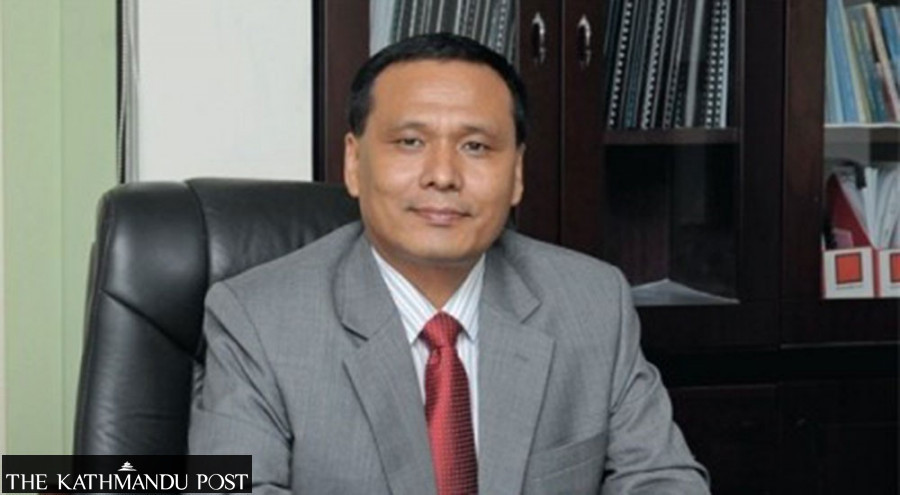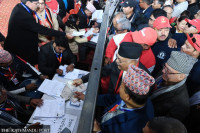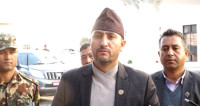National
Kul Man Ghising blames bureaucracy for slow progress in power line projects
Nepal Electricity Authority accuses forest authorities of hindering the New Butwal-Bardaghat Transmission project.
Prithvi Man Shrestha
The Department of Forests in May agreed to give permission to the New Butwal-Bardaghat Transmission Line Project Office to cut 5,822 trees inside national and community forests in Nawalparasi (Susta West). The department’s move was in line with a Cabinet decision of December last year.
On May 16, the project office submitted a request with the Department of Forests for signing an agreement, and subsequently the date of signing the agreement was also fixed. “On the day when the agreement was supposed to be signed, the under-secretary who was authorised to ink the transmission project deal ran away making an excuse that he was going out for lunch,” Kul Man Ghising, managing director of Nepal Electricity Authority, said at a press conference on Sunday. “The under-secretary didn’t come into contact for eight days.”
The project staff spent several days waiting for the under secretary’s return. “Our staff waited for 17 days at the office of the Department of Forests,” said Vishwa Ranjan, chief of the New Butwal-Bardaghat Transmission Line Project. “Only after the director general of the forest department intervened was the agreement signed on June 8.”
Before signing the agreement, the NEA had reached an understanding with the finance ministry to pay fees on five instalments to the department for forest clearance. Of the total amount of Rs279.94 million be paid to the department, the NEA had forwarded Rs35.13 million in the first tranche on May 9.
But officials at the NEA said that even after a consensus was reached with the finance ministry on paying the fee on instalment basis, the under-secretary authorised to sign the agreement, refused to do so.
“The under-secretary had argued that the finance ministry didn’t have authority to tell the NEA to pay the fee in instalments,” Ranjan said. “Finally, an agreement could be signed after 17 days.”
After an agreement was signed with the forest department, relevant documents were taken to the Division Forest Office in Nawalparasi to issue orders for cutting the trees. “But the division forest office is not entertaining our request,” said Ranjan.
NEA officials say that the project is very important for delivering nearly 300MW of additional power to be generated in the Kaligandaki corridor to Butwal from where power could be delivered to various other parts of the country in addition to exporting power to India once the New Butwal-Gorakhpur Cross Border Line is built in the next few years.
But, according to NEA officials, it took nearly four years to get the clearance for felling the trees. Earlier, the project had taken approval for forest clearance for a section of the transmission line. For getting clearance for a second time, the Cabinet on December 11 last year had decided to give permission to fell 5,822 trees, but the decision has not yet been implemented.
“The contractor has been on board for the last four years, but we have not provided a site to carry out its work,” said Ghising. “The remaining task can be completed in less than six months, but the site clearance process takes several years.”
With the NEA continuing to face administrative delays at the forest and land management authorities not only in the New Butwal-Bardaghat Transmission Line Project but in many other projects as well, NEA officials said. Ghising looked visibly angry when he talked about alleged non-cooperation by government agencies.
“We don’t get permission from the forest authorities to fell trees even five years after a Cabinet nod,”said Ghising, adding that it is not possible for the NEA to work without support and cooperation from other government agencies.
He said that even though transmission line projects are being undertaken nationwide, there have been obstructions by both state agencies and the local people.
According to the NEA, currently, Nepal has been transmitting power from east to west of the country using the 132kV transmission infrastructure. “How can we deliver the growing demand of power with 132kV line,” Ghising asked pointing out the local obstructions in the 400kV Inaruwa-Dhalkebar-Hetauda and 220kV Hetauda-Bharatpur-Bardaghat-New Butwal transmission lines.
After three and a half years since issuing the stay order, the Supreme Court in early July last year had vacated the order clearing the way for erecting pylons at Padariya in Lahan Municipality of Siraha district under the Inaruwa-Dhalkebar-Hetauda transmission line.
Likewise, in late June last year, the Supreme Court had vacated its year-long stay order lifting the restriction on two transmission lines in the Bardaghat area.
With power generation in the country set to grow in the upcoming years, poor transmission infrastructure has emerged as a major concern.
“We cannot deliver power from Dhalkebar to Tanakpur because of poor transmission infrastructure, and we have to rely on electricity imported through Tanakpur to power the far-western region even during the wet season,” said Ghising.
Nepal has been exporting power to India in the wet season which starts in June and lasts until November when the country produces surplus power.
Ghising also stressed that a high capacity transmission line was also required even to increase Nepal’s power export to India.
During Prime Minister Pushpa Kamal Dahal’s visit to India from May 31 to June 3, Indian Prime Minister Narendra Modi had announced that the southern neighbour would buy power up to 10,000MW from Nepal in 10 years.
“We need to invest around Rs800 billion to build infrastructure for increasing domestic consumption and boost exports,” said Ghising.




 20.12°C Kathmandu
20.12°C Kathmandu















